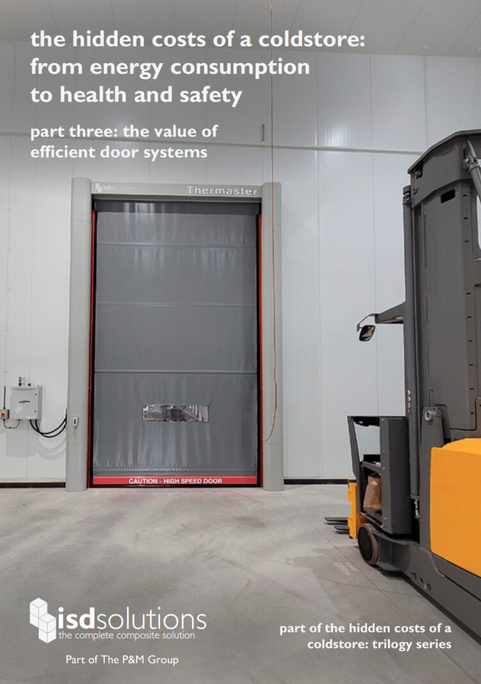Gloucester, UK: Coldstore owners could be wasting tens of thousands of pounds a year due to increased energy consumption from poor door installation and use, says a report from IDS-Solutions.
That’s the key finding of a new report issued by industry experts ISD Solutions in collaboration with the Cold Chain Federation this month. The report, the last in a trilogy published by the partner organisations in 2023, looks at how to improve coldstore energy efficiency by better door installation, usage and maintenance. It highlights air infiltration accounts for 32% of heat gain in a cold store, second only to product load which in turn contributes 39% of heat gain.
One example shows potential energy savings of more than £20,000 a year for a door left open for just 30 minutes, three times a day. This equates to 15.76 tonnes of CO2 emissions, and the report details the easy solution that was implemented to realise these benefits. “Doors are massively important in improving energy performance of a facility,” said Joanne Swift, group sustainability manager at The P & M Group, the parent company of ISD Solutions.
“The reasons that doors contribute to inefficiencies in a coldstore fall into three broad categories,” she continued. “Firstly, we see incorrect specification of doors during the coldstore build phase, based on a lack of understanding of the day-to-day practical usage of the facility.

“Secondly, energy inefficiency is driven by operational procedures which prioritise ease and speed of use over minimising air flow in and out of cold spaces.
“Thirdly, we have the common and misguided prioritisation of thermal efficiency over air leakage. We cannot emphasise enough that in high usage areas the energy savings from solid leaf insulated doors are generally dwarfed by those secured through air tightness and minimising air flow.
“Indeed, with figures showing that air infiltration accounts for 32 per cent of heat gain in a coldstore this is an area which facility owners need to get right at the earliest possible stage of construction planning.
“However, even if inappropriate doors have been installed, there are remedies for the problem which can often be simple and effective. We are happy to share these with readers of our new report and we are proud to contribute our expertise to helping companies make their businesses more efficient and sustainable.”
Co-contributors to the report were Tom Southall from Cold Chain Federation and Dermot Cotter from Star Technical Solutions. The report also touches on temperature differentials, health and safety risks and guidelines for good maintenance, as well as advice for companies looking to construct a new coldstore.

Tom Southall, executive director, Cold Chain Federation, said: “Our industry is very energy intensive, but we can now add to the plethora of resources for climate action with The P & M Group’s important trilogy of reports focusing on pipework, building fabric and door openings.
“We stand at a pivotal moment in our history. The fate of our planet and climate is at a juncture where what happens next will determine the extent of the worst impacts of climate change. So, the time is now, the help is out there – the rest is over to you.”
Adrian Smith, managing director, ISD Solutions, said: “ISD understands the importance of efficient and high quality doors, after years of manufacture, installation and maintenance. We often see poorly maintained or misused door systems. This report demonstrates the financial and environmental benefits of regular door maintenance and appropriate system selection, offering sound advice for owners and operators seeking to improve the efficiency of their temperature-controlled facilities.”
Dermot Cotter, managing director, Star Technical Solutions, said: “This report explains the financial burden placed on a business and environmental impact when operating with inefficient doors. It is critical that industry invests in the most efficient door technologies to move towards increased sustainability and for the UK to meet its carbon emission objectives. Invest wisely to reduce your business operational costs and carbon emissions.”
The report is available to downloaded.







